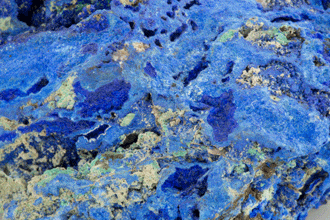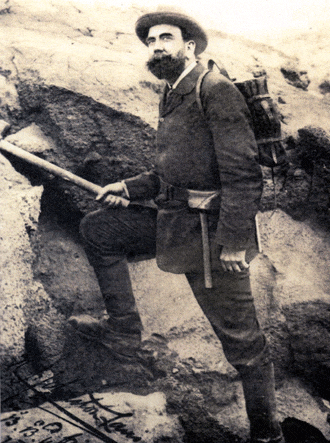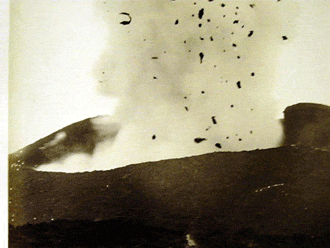Violent Earth – The Legacy of Dr Johnston-Lavis
By Nick J Booth, on 28 August 2013
The UCL Geology Collection contains over 100,000 objects, mostly specimens collected for and used in teaching, or material collected in the course of research. Most of these are, unsurprisingly, geological specimens. However within the Geological Collections there is a special sub-collection which includes not just specimens, but also art works, photographs and books of special interest to the history of the study of volcanology. This is known as the Johnston-Lavis Collection.
Dr Henry Johnston-Lavis was born in London in 1856. He trained as a doctor at UCL and UCLH, gaining a first class degree in practical chemistry in 1874, and a first in clinical medicine in 1878. He moved to Naples in 1879, where he established a practice looking after the English speaking community. By all accounts he was a good doctor, and popular with his patients. There are accounts of him working day and night during a Cholera outbreak, despite being ‘dreadfully afraid’ of the disease. Amongst notable medical work he carried out was the discovery of the link between shell fish and gastric problems.
However while medicine was his job, his real love appears to have been geology, and specifically Volcanology. There’s a lovely story that his interest in Geology stemmed from an incident as a child at the Grammer School in Iver, Buckinghamshire, when another pupil threw a stone at him. This stone turned out to be a flint cast of a fossil sea urchin, and he was hooked. The first specimen listed in his catalogue is a flint sea urchin which he referred to as his ‘philosophers stone’, though (annoyingly) I cant find out if this was THE fossil sea urchin.
Johnston-Lavis joined the Geological Association in 1874, and was voted in as a fellow of the Geological Society in 1875, despite being theoretically too young to join. In 1876 he discovered a new species of early amphibian after a land slip near Sidmouth in Devon, which was named Labyrinthodon lavisi in his honour.
However it was the geology of volcanoes, and specifically Italian volcanos, that seems to have been his true love. A quote from a friend, BB Woodward, describing one particularly memorable night on Vesuvius best illustrates his passion for the subject.
‘At about 2.30am the ground beneath our feet trembled violently and, amidst flashes of lightening, a new gap burst forth a great stream of molten lava, which seemed to bear down on us precipitously. Terrified by the sudden unexpected explosion, we retreated as fast as we could, but found our way barred by the earlier stream, which was still copiously gushing out. Believing ourselves entirely cut off, and fearing least we should be overwhelmed by either scorching lava or the scalding irrespirable vapours, we proceeded to clamber up the almost perpendicular face of the Somma escarpment.’
Luckily Dr Johnston-Lavis had previously climbed the escarpment, and could lead the way to safety. Woodward does go on to say that once they climbed to safety they stopped to watch the rest of the eruption, so presumably they felt safe by that point.
All of his work on Vesuvius resulted in the production of its first geological map, published in 1891. Following on from this he was appointed Professor of Volcanology at Royal University of Naples in 1893.
During his life Johnston-Lavis published over 200 articles, mostly on Volcanology, and visited not only Italy but also America and Iceland, which given his interests I imagine he loved. He tragically died in a car crash near Bourges (Cher) in France in September 1914. He bequeathed his collection to UCL, where much of it is still available for teaching, research and display.
The contents of this blog post have been heavily cribbed from ‘Violent Earth: The unique legacy of Dr. Johnston-Lavis’ written by my colleague Wendy Kirk. It’s available to buy during Rock Room opening hours (1-3pm every Friday).
Specimens from the Johnston-Lavis Collection are on display until September 14th as part of the ‘Nature Reserves’ Exhibition at GV Art Gallery.
On the 11th September GV Art Gallery will host a very special one-off event. ‘Handle with care’ will feature UCL Museums and Earth Sciences staff discussing Johnston-Lavis, his collections and will provide the public with a rare opportunity to handle parts of the collection for a really up close view. The event is free and more details can be found here.
Nick Booth is one of the Curators of the Teaching and Research Collections.
3 Responses to “Violent Earth – The Legacy of Dr Johnston-Lavis”
- 1
-
2
Celebrating Marvellous Maps! | UCL UCL Museums & Collections Blog wrote on 9 October 2014:

[…] • The first geological map ever made of Vesuvius, drawn up by Dr Johnston-Lavis. […]
-
3
The Rock Room will close at the end of May… | UCL Museums & Collections Blog wrote on 7 April 2016:

[…] The Rock Room has been in its present location since 1908, although then there was a second room dedicated to Physical, Stratigraphical, and Palaeontological collections (not quite such a catchy name as ‘The Rock Room’ though). During this time the collections were cared for by Edith Goodyear, under the professorship of Edmund Garwood (Edmund has a lecture theatre named after him, Edith a room in the Lewis’ Building). During this time a number of important collections were donated, including the Johnston-Lavis volcanological collection. […]
 Close
Close






[…] – Tuesday started with a reminder in my calendar that it was the 99th anniversary of the death of Dr Johnston-Lavis, an important geological collector who had bequeathed his impressive vulcanolgical collection to […]